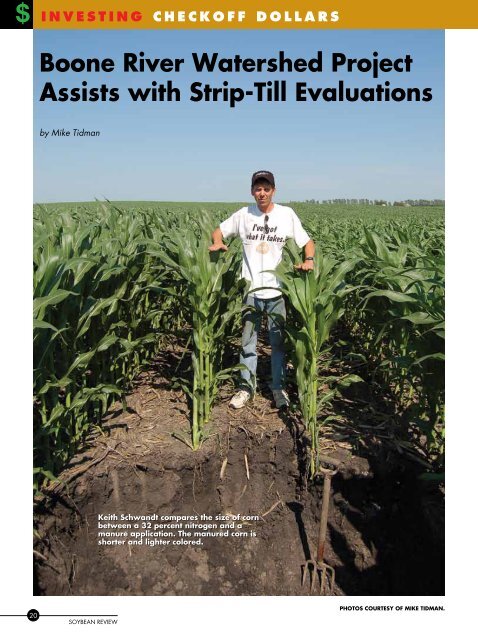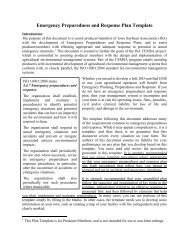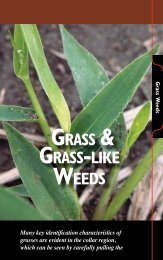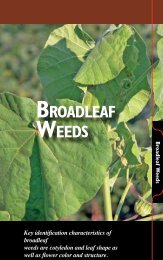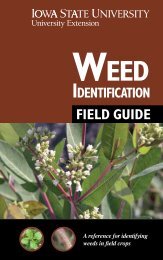Boone River Watershed Project Assists with Strip-Till Evaluations
Boone River Watershed Project Assists with Strip-Till Evaluations
Boone River Watershed Project Assists with Strip-Till Evaluations
You also want an ePaper? Increase the reach of your titles
YUMPU automatically turns print PDFs into web optimized ePapers that Google loves.
$ I n v e s t i n g C h e c k o f f D o l l a r s<br />
<strong>Boone</strong> <strong>River</strong> <strong>Watershed</strong> <strong>Project</strong><br />
<strong>Assists</strong> <strong>with</strong> <strong>Strip</strong>-<strong>Till</strong> <strong>Evaluations</strong><br />
by Mike Tidman<br />
Keith Schwandt compares the size of corn<br />
between a 32 percent nitrogen and a<br />
manure application. The manured corn is<br />
shorter and lighter colored.<br />
20<br />
SOYBEAN REVIEW<br />
Photos courtesy of Mike Tidman.
Schwandt examines soil structure, evidence of earthworm activity and rooting depth of corn in a strip-till<br />
field. He says, “Looking at the dirt is how you learn and figure this stuff out.”<br />
Keith Schwandt’s neighbors might<br />
see some things that seem out of<br />
the ordinary – such as a backhoe<br />
digging in his cornfield in July or<br />
red flashlights dancing among the<br />
rows at 3:00 a.m. But these occurrences<br />
are just part of Schwandt’s quest to better<br />
understand his farming operation.<br />
Schwandt farms near Webster<br />
City, in the <strong>Boone</strong> <strong>River</strong> and South<br />
Fork (Iowa <strong>River</strong>) watersheds, and he<br />
participates in the Iowa Soybean Association’s<br />
<strong>Boone</strong> <strong>River</strong> <strong>Watershed</strong><br />
<strong>Project</strong> and the CEMSA (Certified Environmental<br />
Management Systems<br />
for Agriculture) program.<br />
He is working <strong>with</strong> Gary Hammitt,<br />
ISA agricultural environmental specialist,<br />
to improve the efficiency and performance<br />
of his farm. Hammitt has helped<br />
him <strong>with</strong> troubleshooting in-field concerns,<br />
planning and testing to validate<br />
his practices.<br />
Schwandt says ISA’s assistance in<br />
evaluating practices like strip till would<br />
help many farmers in his area.<br />
“One of the best things farmers<br />
around here could do is accept Gary<br />
Hammitt’s challenge to go out and do<br />
40 acres of strip till beside their conventional<br />
tillage,” Schwandt says. “Gary can<br />
help them rent a machine or contract the<br />
work, so they don’t have to invest to run<br />
the experiment.”<br />
Schwandt says he got interested in<br />
strip till as a way to reduce tillage time<br />
and cost.<br />
“A few years ago, I told my dad I’m<br />
not going to do as much tillage when he’s<br />
gone – there’s got to be a different way to<br />
farm,” Schwandt says. “But after thinking<br />
about that, I thought I should start trying<br />
new ideas now, while I’ve got his 40 years<br />
experience standing by me.<br />
“He agreed to it, so we got started<br />
<strong>with</strong> a 12-shank in-line ripper,” Schwandt<br />
continues. “In the fall, we put the wings<br />
up and pulled eight shanks at 18 inches<br />
deep to break up hard pan. In spring, we<br />
put the wings down and ripped 12 rows<br />
<strong>with</strong> a tank behind the unit, and we applied<br />
liquid NPK in the standing rows.<br />
Then we came back and planted in that,<br />
and it was one of the best crops we ever<br />
had. The roots were huge; they went<br />
straight down. Everything about it made<br />
a lot of sense, so we did that for a couple<br />
years. Since then, we’ve moved to a<br />
24-row unit – we are practicing controlled<br />
traffic patterns to reduce compaction so<br />
the 24-row unit matches up <strong>with</strong> our<br />
24-row planter.”<br />
Schwandt says putting fertilizer below<br />
the corn drives the root deeper and<br />
insures that it is available.<br />
“I spend so much money on fertilizer,<br />
I want it right under the plant, where<br />
the corn plant can find it and use it,”<br />
Schwandt says.<br />
Schwandt says the changes in<br />
management are causing changes in<br />
the soil.<br />
“When we moved from full-width<br />
tillage to strip till, we also switched from<br />
NH3 to 32 percent, and there was an explosion<br />
of earthworms and night crawlers<br />
in the soil,” Schwandt says. “I think<br />
because we leave last years row in place,<br />
the worms, night crawlers and bacteria<br />
are left undisturbed and can graze on the<br />
residue. They’re kind of like the livestock<br />
people don’t see.<br />
“One night I couldn’t sleep, and it was<br />
just about done raining. So I went out to<br />
the field, got on my hands and knees <strong>with</strong><br />
a red light, and I started looking at the<br />
dirt and watching the worms. I watched<br />
this night crawler stretch out from a hole<br />
and pull all kinds of stuff toward him and<br />
into the hole. I couldn’t believe it. Maybe<br />
the neighbors think I’m nuts, but that’s<br />
how you learn and figure this stuff out.”<br />
Schwandt also digs holes in the field<br />
in the middle of the growing season to<br />
better understand how the soil works.<br />
“I’ve dug holes so that I can see what’s<br />
happening under the surface of the soil,”<br />
Schwandt says. “I’ve seen parts of tassels,<br />
deep worm holes, root structure – all of<br />
it is there. When you see it, you begin to<br />
better understand it.”<br />
Schwandt says ISA’s technical assistance<br />
has been helpful in measuring the<br />
effect of his management on profitability<br />
and the environment.<br />
“I don’t know exactly how to put a<br />
dollar figure on it yet – that’s what we’re<br />
trying to do,” Schwandt says. “But I’m<br />
looking at my crops and at the results I’m<br />
getting, and it seems like a good thing<br />
to me.”<br />
February 2009<br />
21


